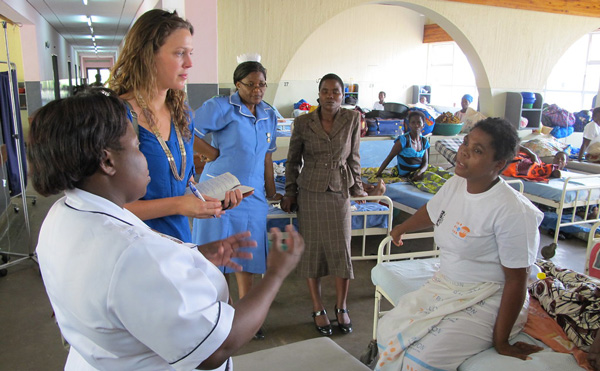Using evidence and collaboration to improve MDT work in Malawi
Author: Beverley Johnson
Cardiff University and Wales Centre of Evidence Based Practice
I was very fortunate to be invited to a join a team of Cardiff academics who in 2019 had been awarded Erasmus + funding to work with a university in Malawi to improve multidisciplinary teamwork (MDT). The project took place in a medical ward, in a large government hospital. I was responsible for improving the ward rounds and undertook the project as part of the JBI SPIDER (Strategic Partnership in Innovation and Development of Evidenced-Based Healthcare) project. The project involved implementing evidence into practice using the JBI Evidence Implementation Framework and online resources.
Introduction
I have chosen to write about this experience as it is central to the first pillar of intersectoral action for health. This example focuses on overcoming challenges in a resource-limited setting to improve multidisciplinary practice. It involves close collaboration and education, identifying the challenges of quality improvement in low- to middle-income countries and recognizing what can and can’t be achieved.
Background
Ward rounds are crucial systems of communication that allow patients to be reviewed, and plans created. Due to the complex nature of ward rounds, the Royal College of Physicians and the Royal College of Nursing have jointly produced best practice guidelines for ward rounds. There is also evidence suggesting that well-structured ward rounds can shorten patient stay and reduce adverse effects and mortality rates. In addition, nursing and patient satisfaction can be higher when ward rounds are inclusive.
The JBI SPIDER project has a clear implementation framework with three overarching domains: (1) Implementation planning, (2) Baseline assessment and implementation, and (3) Impact evaluation. I therefore began the process with implementation planning, which involved collaborating with the university and clinical team in Malawi to identify the problem. We held a workshop with the university staff to bring together stakeholders and identify an area that the clinical team wanted to improve.
The problem
Upon arrival at the hospital in Malawi, the lack of resources was evident. The ward had 50 beds, but its capacity was often exceeded to 100, with patients being nursed on the floor. There was a lack of supplies, staff, and equipment. The desire to improve care despite these challenges was very humbling.
The stakeholders identified several areas that they wished to improve, but finally decided on improving multidisciplinary ward rounds. The clinical team found these to be medically driven, lacking in structure, and not involving nurses, which is crucial in the holistic assessment of the patient. Indeed, the Francis Report which investigated the failings in the Mid Staffordshire NHS Trust scandal, suggested that the absence of the nurse on ward rounds had clear consequences for communication and patient safety.
After completing a literature review and using the tools available from JBI, we were able to conduct a baseline audit of MDT. This audit surprisingly identified that several of the criteria were being met, which was incongruent with the stakeholder group identifying that there was no structure, lack of role expectations, responsibilities, or documentation. This identified some of the barriers of survey-based audits. However, crucially, the audit indicated that there was only some compliance with nurses being present in the ward round (33%). By communicating with the stakeholders, we decided to focus on ensuring that nurses were consistently able to attend the ward rounds. This was felt to be crucial to foster good communication and enable holistic ward rounds to occur.
Identifying the cause
By conducting a JBI GRiP analysis, I was able to pinpoint the reason for poor nurse attendance of the ward rounds and identify some potential strategies to rectify this. Ward rounds occurred on a set day, with five ward rounds occurring simultaneously. The ward rounds were teaching rounds, which could take 3 hours to complete, which inevitably prevented nurses from attending.
The solution
With the ward nurses keen to attend these rounds, the main strategy employed involved presenting evidence to the medical team on the importance of nurses attending and asking whether ward rounds could take place on different days or be staggered. However, the medical team were not willing to change their practice. Part of this was down too custom and practice, and partly down to patient expectations. The solution was identified by the unit matron, who recognized the need for nurses to be present at the ward rounds and ensured that there were additional nurses on shift on the days that ward rounds occurred.
The follow up audit identified that compliance for nurses being present at ward rounds had increased to 100%.
Impact
This project has made an impact on one ward in a hospital in Malawi. Hopefully, with staff mobility and evidence of its benefits, it will spread to other areas of the hospital, but resources are needed to manage this. Anecdotal evidence from one of the consultants indicated that since the start of the project, there has been a marked improvement in the morale of nursing staff, with motivation to engage in ward rounds and communicate patient needs being evident. Qualitative analysis has also identified that nurses are feeling more valued and listened to, there is more professional respect, and there is greater communication at the bedside.
Challenges
Although the project was successful in achieving its aim, there were a number of challenges along the way.
The main challenge was the COVID-19 pandemic. This project initially commenced before the pandemic, which delayed all progress for nearly 2 years. During COVID, the key stakeholders remained committed, and regular meetings were held via online platforms to support the team in Malawi and maintain momentum. Post pandemic, the team in Malawi managed to implement the changes with additional staff resources. Five years on, nurses are still attending the ward rounds.
The other challenge was due to cultural and patient expectations. Patients expected to be reviewed simultaneously, and changing that culture to enable ward rounds to happen on different days was beyond the scope of the project.
Key lessons
The key lesson learnt from this project was that change cannot take place without an analysis that enables an understanding of the constraints and cultural context of the area of practice. It was not the lack of resources that prevented the implementation of change, but the greatest barrier was in fact cultural practice.
Key to the success of this project was the stakeholder team in Malawi, which maintained commitment and enthusiasm. Communication continued online during the pandemic and due to the team’s commitment, we were successful in improving one crucial element of ward rounds. This initial contact and communication with the hospital has allowed further projects to develop in maternity services and cross-university teaching, which can only be positive for all involved.
Recommendations
- Quality improvement projects need to have buy-in from all stakeholders.
- Awareness of cultural norms and expectations is essential.
- Where possible, implementations need to be resource-neutral or resources need to be ring-fenced for the future.
- Maintaining regular communication with the team locally is important when dealing with challenges.

“.... by turning the flywheel, we can effectively mobilise evidence into practice, creating a self-reinforcing cycle of improvement in healthcare outcomes. This accelerates the path from ‘Evidence to Impact’.”
References
Epstein N. E. (2014). Multidisciplinary in-hospital teams improve patient outcomes: A review. Surgical Neurology International, 5(Suppl 7), S295–S303. https://doi.org/10.4103/2152-7806.139612
Francis, R. The Mid Staffordshire NHS Foundation Trust Inquiry. https://assets.publishing.service.gov.uk/media/5a7ba0faed915d13110607c8/0947.pdf
Jensen, B.E., Found, P.A., Williams, S.J., & Walley, P. (2016). Improving the efficiency and effectiveness of ward rounds. International Journal of Quality and Service Services, 8(3) 279-297.
DOI:10.1108/IJQSS-05-2016-0039
Kim, M. M., Barnato, A. E., Angus, D. C., Fleisher, L. A., & Kahn, J. M. (2010). The effect of multidisciplinary care teams on intensive care unit mortality. Archives of Internal Medicine, 170(4), 369–376. https://doi.org/10.1001/archinternmed.2009.521
Porritt, K., McArthur, A., Lockwood, C., & Munn, Z. (2023). JBI's approach to evidence implementation: a 7-phase process model to support and guide getting evidence into practice. JBI Evidence Implementation, 21(1), 3–13. https://doi.org/10.1097/XEB.0000000000000361
Royal College of Physicians and Royal College of Nursing Modern Ward Rounds. (2021). Good practice for multidisciplinary inpatient review.
https://www.rcp.ac.uk/media/iwgpgxoa/ward_round_report_0.pdf
Will, K. K., Johnson, M. L., & Lamb, G. (2019). Team-based care and patient satisfaction in the hospital setting: a systematic review. Journal of Patient-Centered Research and Reviews, 6(2), 158–171. https://doi.org/10.17294/2330-0698.1695
To link to this article - DOI: https://doi.org/10.70253/FEUK2409
Co-publication declaration
Johnson, B., Bennett, C., Carrier, J., Watkins, D., Mula, C., Kazidule, R., Salley, P., Klugar, M., & Klugarova, J. (2024) Introducing multidisciplinary ward rounds in Malawi: a best practice implementation project. JBI Evidence Implementation, 22(0):1–9. DOI: 10.1097/XEB.0000000000000443
Disclaimer
The views expressed in this World EBHC Day Blog, as well as any errors or omissions, are the sole responsibility of the author and do not represent the views of the World EBHC Day Steering Committee, Official Partners or Sponsors; nor does it imply endorsement by the aforementioned parties.
